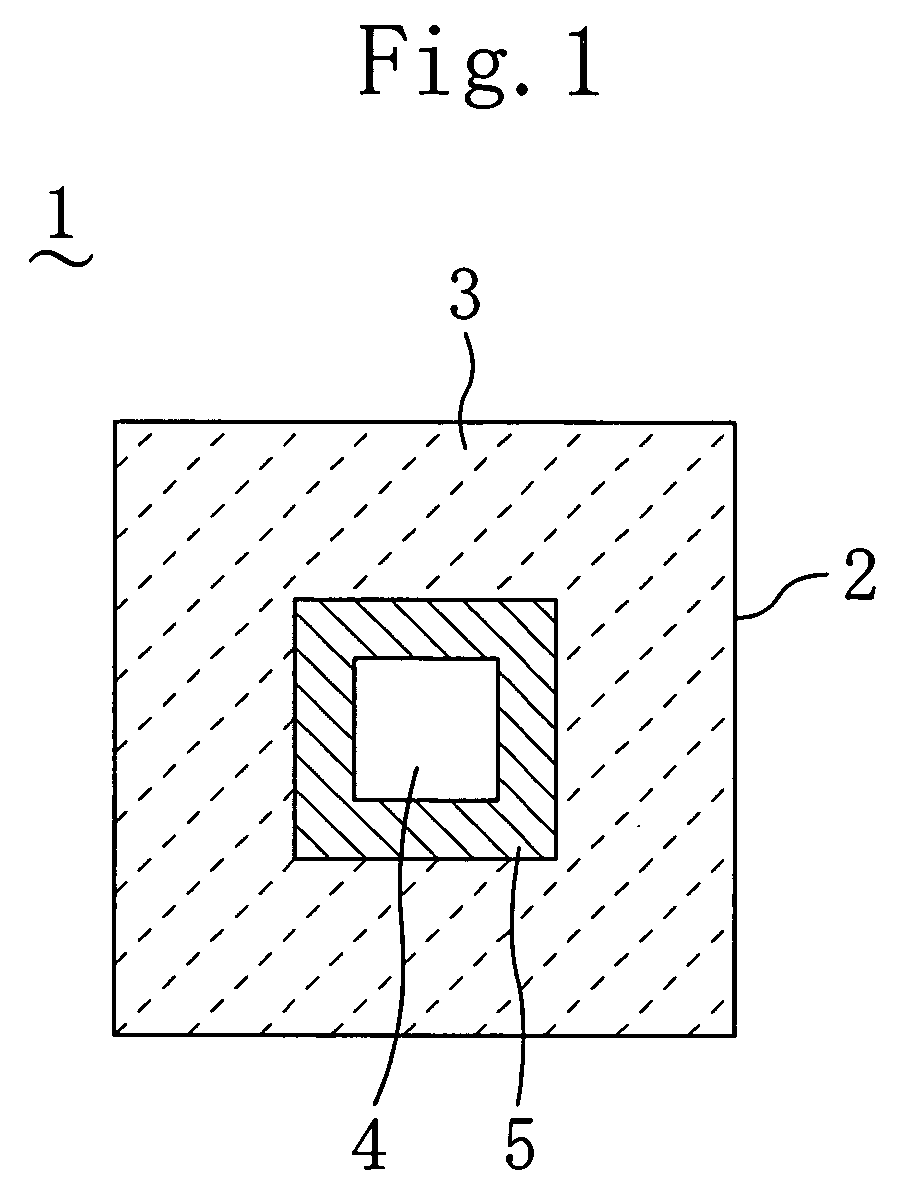Photomask, method for producing the same, and method for forming pattern using the photomask
- Summary
- Abstract
- Description
- Claims
- Application Information
AI Technical Summary
Benefits of technology
Problems solved by technology
Method used
Image
Examples
first embodiment
[0107]First, a method for improving resolution with a photomask invented by the inventor of the present application to achieve the present invention, and, more specifically, an “outline enhancement method” to improve the resolution of an isolated space pattern will be described.
[0108]FIG. 1 is a plan view of a photomask using an outline enhancement method in accordance with a first embodiment of the present invention (hereinafter, referred to as an “outline enhancement mask”). More specifically, FIG. 1 shows a plan view of an outline enhancement mask in which a light-transmitting portion corresponding to an isolated contact pattern is provided.
[0109]As shown in FIG. 1, an outline enhancement mask 1 includes a transparent substrate 2 having light-transmitting properties with respect to exposure light, a semi-light-shielding portion 3 formed on the principal surface of the transparent substrate 2 and having a transmittance which allows exposure light to be partially transmitted, a lig...
second embodiment
[0175]Next, a photomask using a method for improving resolution with a photomask invented by the inventor of the present application to achieve the present invention, and, more specifically, a photomask using a “center line enhancement method” to improve the resolution of isolated line patterns will be described.
[0176]FIG. 12 is a plan view of a photomask using a center line enhancement method in accordance with a second embodiment of the present invention (hereinafter, referred to as “image enhancement mask”). More specifically, FIG. 12 is a plan view of an image enhancement mask for forming an isolated line pattern.
[0177]As shown in FIG. 12, an image enhancement mask 6 includes a transparent substrate 7 having light-transmitting properties with respect to exposure light, a semi-light-shielding portion 8 formed on the transparent substrate 7, having a transmittance which allows part of exposure light to be transmitted and corresponding to an isolated line pattern, and a phase shift...
third embodiment
[0190]Hereinafter, a photomask in accordance with a third embodiment of the present invention and a method for generating mask data for the photomask will be described with reference to the accompanying drawings.
[0191]FIG. 17 shows a flow chart of a mask data generation method in accordance with the third embodiment, using the outline enhancement method and the center line enhancement method. More specifically, FIG. 17 is a flowchart of a mask data generation method in which a mask pattern is formed based on a desired pattern which is to be formed using a photomask. Also, FIGS. 18(a) through 18(d) and FIGS. 19(a) and 19(d) are plan views illustrating respective process steps for forming a mask pattern for space pattern formation by using the mask data generation method of FIG. 17. Moreover, FIGS. 20(a) through 20(d) and FIGS. 21(a) through 21(c) are plan views illustrating respective process steps for forming a mask pattern for line pattern formation by using the mask data generatio...
PUM
 Login to View More
Login to View More Abstract
Description
Claims
Application Information
 Login to View More
Login to View More - R&D
- Intellectual Property
- Life Sciences
- Materials
- Tech Scout
- Unparalleled Data Quality
- Higher Quality Content
- 60% Fewer Hallucinations
Browse by: Latest US Patents, China's latest patents, Technical Efficacy Thesaurus, Application Domain, Technology Topic, Popular Technical Reports.
© 2025 PatSnap. All rights reserved.Legal|Privacy policy|Modern Slavery Act Transparency Statement|Sitemap|About US| Contact US: help@patsnap.com



